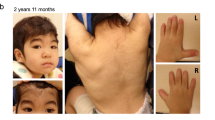Abstract
Chromatin remodeling is a complex process shaping the nucleosome landscape, thereby regulating the accessibility of transcription factors to regulatory regions of target genes and ultimately managing gene expression. The SWI/SNF (switch/sucrose nonfermentable) complex remodels the nucleosome landscape in an ATP-dependent manner and is divided into the two major subclasses Brahma-associated factor (BAF) and Polybromo Brahma-associated factor (PBAF) complex. Somatic mutations in subunits of the SWI/SNF complex have been associated with different cancers, while germline mutations have been associated with autism spectrum disorder and the neurodevelopmental disorders Coffin–Siris (CSS) and Nicolaides–Baraitser syndromes (NCBRS). CSS is characterized by intellectual disability (ID), coarsening of the face and hypoplasia or absence of the fifth finger- and/or toenails. So far, variants in five of the SWI/SNF subunit-encoding genes ARID1B, SMARCA4, SMARCB1, ARID1A, and SMARCE1 as well as variants in the transcription factor-encoding gene SOX11 have been identified in CSS-affected individuals. ARID2 is a member of the PBAF subcomplex, which until recently had not been linked to any neurodevelopmental phenotypes. In 2015, mutations in the ARID2 gene were associated with intellectual disability. In this study, we report on two individuals with private de novo ARID2 frameshift mutations. Both individuals present with a CSS-like phenotype including ID, coarsening of facial features, other recognizable facial dysmorphisms and hypoplasia of the fifth toenails. Hence, this study identifies mutations in the ARID2 gene as a novel and rare cause for a CSS-like phenotype and enlarges the list of CSS-like genes.



Similar content being viewed by others
References
Allen AS et al (2013) De novo mutations in epileptic encephalopathies. Nature 501:217–221. doi:10.1038/nature12439
Bramswig NC et al (2015) Exome sequencing unravels unexpected differential diagnoses in individuals with the tentative diagnosis of Coffin–Siris and Nicolaides–Baraitser syndromes. Hum Genet 134:553–568. doi:10.1007/s00439-015-1535-8
Coffin GS, Siris E (1970) Mental retardation with absent fifth fingernail and terminal phalanx. Am J Dis Child 119:433–439
Hargreaves DC, Crabtree GR (2011) ATP-dependent chromatin remodeling: genetics, genomics and mechanisms. Cell Res 21:396–420. doi:10.1038/cr.2011.32
He L et al (2014) BAF200 is required for heart morphogenesis and coronary artery development. PLoS One 9:e109493. doi:10.1371/journal.pone.0109493
Hempel A et al (2016) Deletions and de novo mutations of SOX11 are associated with a neurodevelopmental disorder with features of Coffin–Siris syndrome. J Med Genet 53:152–162. doi:10.1136/jmedgenet-2015-103393
Hoyer J et al (2012) Haploinsufficiency of ARID1B, a member of the SWI/SNF-a chromatin-remodeling complex, is a frequent cause of intellectual disability. Am J Hum Genet 90:565–572. doi:10.1016/j.ajhg.2012.02.007
Kosho T, Okamoto N (2014) Genotype-phenotype correlation of Coffin–Siris syndrome caused by mutations in SMARCB1, SMARCA4, SMARCE1, and ARID1A. Am J Med Genet C Semin Med Genet 166C:262–275. doi:10.1002/ajmg.c.31407
Kosho T, Miyake N, Carey JC (2014) Coffin–Siris syndrome and related disorders involving components of the BAF (mSWI/SNF) complex: historical review and recent advances using next generation sequencing. Am J Med Genet C Semin Med Genet 166C:241–251. doi:10.1002/ajmg.c.31415
Miyake N, Tsurusaki Y, Matsumoto N (2014) Numerous BAF complex genes are mutated in Coffin–Siris syndrome. Am J Med Genet C Semin Med Genet 166C:257–261. doi:10.1002/ajmg.c.31406
Nagase T, Kikuno R, Nakayama M, Hirosawa M, Ohara O (2000) Prediction of the coding sequences of unidentified human genes. XVIII. The complete sequences of 100 new cDNA clones from brain which code for large proteins in vitro. DNA Res 7:273–281
Sakai Y et al (2016) De novo truncating mutation of TRIM8 causes early-onset epileptic encephalopathy. Ann Hum Genet 80:235–240. doi:10.1111/ahg.12157
Santen GW et al (2012) Mutations in SWI/SNF chromatin remodeling complex gene ARID1B cause Coffin–Siris syndrome. Nat Genet 44:379–380. doi:10.1038/ng.2217
Santen GW et al (2013) Coffin–Siris syndrome and the BAF complex: genotype-phenotype study in 63 patients. Hum Mutat 34:1519–1528. doi:10.1002/humu.22394
Shang L et al (2015) Mutations in ARID2 are associated with intellectual disabilities. Neurogenetics 16:307–314. doi:10.1007/s10048-015-0454-0
Tsurusaki Y et al (2012) Mutations affecting components of the SWI/SNF complex cause Coffin–Siris syndrome. Nat Genet 44:376–378. doi:10.1038/ng.2219
Tsurusaki Y et al (2014a) De novo SOX11 mutations cause Coffin–Siris syndrome. Nat Commun 5:4011. doi:10.1038/ncomms5011
Tsurusaki Y et al (2014b) Coffin–Siris syndrome is a SWI/SNF complex disorder. Clin Genet 85:548–554. doi:10.1111/cge.12225
Van Houdt JK et al (2012) Heterozygous missense mutations in SMARCA2 cause Nicolaides–Baraitser syndrome. Nat Genet 44(445–449):S441. doi:10.1038/ng.1105
Wieczorek D et al (2013) A comprehensive molecular study on Coffin–Siris and Nicolaides–Baraitser syndromes identifies a broad molecular and clinical spectrum converging on altered chromatin remodeling. Hum Mol Genet 22:5121–5135. doi:10.1093/hmg/ddt366
Wilson BG, Roberts CW (2011) SWI/SNF nucleosome remodellers and cancer. Nat Rev Cancer 11:481–492. doi:10.1038/nrc3068
Xu F, Flowers S, Moran E (2012) Essential role of ARID2 protein-containing SWI/SNF complex in tissue-specific gene expression. J Biol Chem 287:5033–5041. doi:10.1074/jbc.M111.279968
Yan Z et al (2005) PBAF chromatin-remodeling complex requires a novel specificity subunit, BAF200, to regulate expression of selective interferon-responsive genes. Genes Dev 19:1662–1667
Zahir FR et al (2016) Intragenic CNVs for epigenetic regulatory genes in intellectual disability: survey identifies pathogenic and benign single exon changes. Am J Med Genet A 170:2916–2926. doi:10.1002/ajmg.a.37669
Acknowledgements
We are grateful to the families for participating in this study. We thank Sabine Kaya and Daniela Falkenstein for excellent technical assistance. This work was supported in part by the German Ministry of Research and Education [Grant Numbers 01GS08164 (HE), 01GS08167 (DW), 01GS08163 (TMS), German Mental Retardation Network] as part of the National Genome Research Network and 01GM1520E (DW) as part of the Chromatin-Net consortium. Exome sequencing on Individual 2 was supported by a Grant from Dart NeuroScience LLC (FVB and OC).
Author information
Authors and Affiliations
Corresponding authors
Ethics declarations
Conflict of interest
On behalf of all authors, the corresponding author states that there is no conflict of interest.
Electronic supplementary material
Below is the link to the electronic supplementary material.
439_2017_1757_MOESM1_ESM.tif
Supplemental Fig. 1: X-ray image of the left hand of individual 2 displaying hypoplastic distal phalanges (TIFF 25738 kb)
Rights and permissions
About this article
Cite this article
Bramswig, N.C., Caluseriu, O., Lüdecke, HJ. et al. Heterozygosity for ARID2 loss-of-function mutations in individuals with a Coffin–Siris syndrome-like phenotype. Hum Genet 136, 297–305 (2017). https://doi.org/10.1007/s00439-017-1757-z
Received:
Accepted:
Published:
Issue Date:
DOI: https://doi.org/10.1007/s00439-017-1757-z




